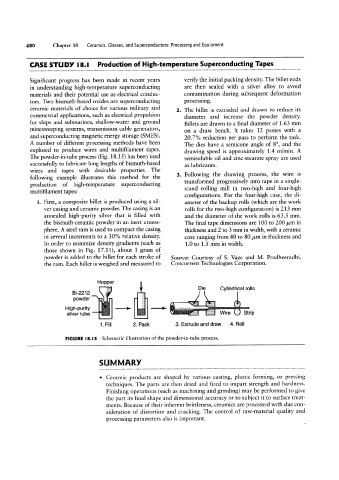Page 500 - 04. Subyek Engineering Materials - Manufacturing, Engineering and Technology SI 6th Edition - Serope Kalpakjian, Stephen Schmid (2009)
P. 500
80 Chapter 18 Ceramics, Glasses, and Superconductors: Processing and Equipment
CASE STUDY l8.l Production of High-temperature Superconducting Tapes
Significant progress has been made in recent years verify the initial packing density. The billet ends
in understanding high-temperature superconducting are then sealed with a silver alloy to avoid
materials and their potential use as electrical conduc- contamination during subsequent deformation
tors. Two bismuth-based oxides are superconducting processing.
ceramic materials of choice for various military and 2. The billet is extruded and drawn to reduce its
commercial applications, such as electrical propulsion diameter and increase the powder density.
for ships and submarines, shallow-water and ground Billets are drawn to a final diameter of 1.63 mm
minesweeping systems, transmission cable generators, on a draw bench. It takes 12 passes with a
and superconducting magnetic energy storage (SMES). 20.7% reduction per pass to perform the task.
A number of different processing methods have been The dies have a semicone angle of 8°, and the
explored to produce wires and multifilament tapes. drawing speed is approximately 1.4 m/min. A
The powder-in-tube process (Fig. 18.15) has been used semisoluble oil and zinc-stearate spray are used
successfully to fabricate long lengths of bismuth-based as lubricants.
wires and tapes with desirable properties. The 3. Following the drawing process, the wire is
following example illustrates this method for the
production of high-temperature superconducting transformed progressively into tape in a single-
stand rolling mill in two-high and four-high
multifilament tapes:
configurations. For the four-high case, the di-
l. First, a composite billet is produced using a sil- ameter of the backup rolls (which are the work
ver casing and ceramic powder. The casing is an rolls for the two-high configuration) is 213 mm
annealed high-purity silver that is filled with and the diameter of the work rolls is 63.5 mm.
the bismuth-ceramic powder in an inert atmos- The final tape dimensions are 100 to 200 nm in
phere. A steel ram is used to compact the casing thickness and 2 to 3 mm in width, with a ceramic
in several increments to a 30% relative density. core ranging from 40 to 80 pm in thickness and
In order to minimize density gradients (such as 1.0 to 1.5 mm in width.
those shown in Fig. 17.11), about 1 gram of
powder is added to the billet for each stroke of Source: Courtesy of S. Vaze and M. Pradheeradhi,
the ram. Each billet is weighed and measured to Concurrent Technologies Corporation.
Hopper
Bi-2212 , I D59 Cylindrical rolls
powder
silver tube "sm were Q Strip
High-purify -> ->
QW.
1 Fill 2. Pack 3. Extrude and draw 4. Roll
FIGURE I8.l5 Schematic illustration of the powder-in-tube process.
SUMMARY
° Ceramic products are shaped by various casting, plastic forming, or pressing
techniques. The parts are then dried and fired to impart strength and hardness.
Finishing operations (such as machining and grinding) may be performed to give
the part its final shape and dimensional accuracy or to subject it to surface treat-
ments. Because of their inherent brittleness, ceramics are processed with due con-
sideration of distortion and cracking. The control of raw-material quality and
processing parameters also is important.

